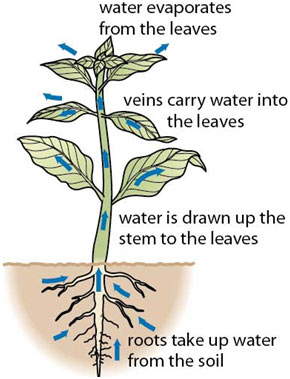Overview
The water movement in plants and its evaporation from aerial parts of plants like leaves, flowers, etc. is transpiration. The great amount of water absorbed by roots is lost as a result of transpiration.
A small amount of water that is absorbed is used for the metabolic and growth activities of plants.
Transpiration is necessary for plants as it is the process of getting rid of excess water and maintaining the proper balance of salts and water.
Transpiration occurs in three ways i.e., cuticular transpiration which is by cuticle, and lenticular transpiration that occurs by some pores on the stem or hard bark of plants called lenticels.
The third one is stomatal which is an important one and occurs through stomata.
Transpiration is vital for the ascent of sap i.e., cohesion, adhesion and surface tension are all required for the movement of water and other substances (food) across the whole plant body.
- 1) Definition of Transpiration
- 2) Types of Transpiration
- 3) Opening and Closing of Stomata
- 4) Ascent of Sap
- 5) Function of Transpiration
- 6) Elements affecting the rate of transpiration
- 7) Multiple Choice Questions (MCQs) with Answers
- 8) FAQs (Frequently Asked Questions) about Transpiration in Plants
- 9) Wrapping up Transpiration in Plants
- 10) You may also like to learn:
Definition of Transpiration
Transpiration is the evaporation of water from plants. Most of the water absorbed by the roots of a plant– as much as 99.5 percent– is not utilized for growth or metabolic process; it is excess water, and it leaves the plant through transpiration. Transpiration is essential for keeping moisture conditions in the environment. As much as 10 percent of the moisture in the Earth’s environment is from the transpiration of water by plants.
Types of Transpiration
There are 3 types of transpiration depending upon the route of the escape of water vapors from the aerial parts of the plant.
- Cuticular transpiration
- Lenticular transpiration
- Stomatal transpiration
(i) Cuticular transpiration: The loss of water in the form of water vapors through the cuticle of leaves is called cuticular transpiration. About 5-7% of the total transpiration takes place through this path.
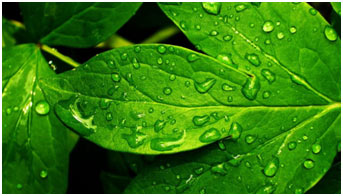
The cuticle present on the upper and lower epidermis of leaves is not completely impenetrable to water and some water is lost in the form of vapors through the cuticle. The thinner the cuticle the greater the rate of transpiration; although the structure of the cuticle is likewise essential. At night, when the stomata are almost closed, cuticular transpiration occurs. Most of the aspects that affect the rate of transpiration, in general, are likewise crucial in controlling the rate of cuticular transpiration.
(ii) Lenticular transpiration: Lenticular transpiration is the loss of water vapors through lenticels present in the stem of some plants. All plants do not have lenticels. The lenticular transpiration is 1-2% of the total transpiration by a plant. These openings, like stomata, are also involved in the exchange of gases between the environment.
When there are strong light and heat, the loss of vapors is rapid since it is governed by diffusion. Lenticels are aerating pores formed in the bark through which the exchange of gases occurs, and water is lost in the form of water vapors (transpiration). Externally, they appear as scars or little protrusions on the surface of the stem. Lenticel consists of a loose mass of little, thin-walled cells. At each lenticel, the cork cambium types oval, spherical, or irregular cells, which are really loosely organized, having great deals of intercellular areas.
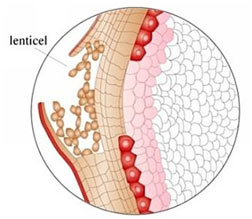
(iii) Stomatal transpiration: It is a kind of transpiration in which the water vapors leave through stomata. In isobilateral leaves, the stomata exist, in both, the upper and lower epidermis e.g., lily and maize leaf. In dorsiventral leaves, the stomata are confined to just the lower epidermis. The guard cells are typically dumble or bean-seed-shaped. The inner concave sides of 2 guard cells enclose the stoma.
This inner side of guard cell has an extremely thick cell wall, but the outer convex side has a thin cell wall. The guard cells are the only cells, of the leaf epidermis, which are not connected by plasmodesmata to other epidermal cells, and which have chloroplasts – and hence are associated with the procedure of photosynthesis.
When these guard cells are turgid, the stoma in between them opens and when the guard cells are flaccid the stoma between them closes. The degree of opening of stomatal pores also affects the rate of transpiration. 90% of overall transpiration in a plant is stomatal. The cells of the mesophyll of the leaf supply an enormous surface area for the loss of water in the form of vapors.
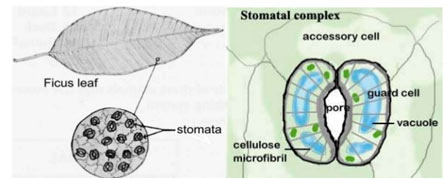
Opening and Closing of Stomata
The guard cells operate as multisensory hydraulic valves. Ecological factors, such as light intensity and quality, temperature, relative humidity, and intracellular CO2 concentration are sensed by guard cells and these signals are incorporated into well-defined stomatal responses. There are two hypotheses that may describe the opening and closing of stomata.
- i) Starch Sugar Hypothesis: The German botanist H. Van Mohl proposed that the guard cells are the only photosynthesizing cells of the epidermis of leaf and sugars are produced in them during day time when light is readily available. When sugar level increases i.e., solute concentration increases or water potential declines – and the guard cells end up being turgid due to entry of water and they separate from one another, and stoma or pore opens. During the night there is no photosynthesis the sugars are either converted into insoluble starch or are used in respiration, which decreases complimentary sugars in the cell. So, the osmotic pressure of guard cells is lowered, and water leaves the guard cells, which become flaccid and stoma or pore in between them closes. However, these procedures are not quick adequate to account for the fast increase in turgor, of guard cells.
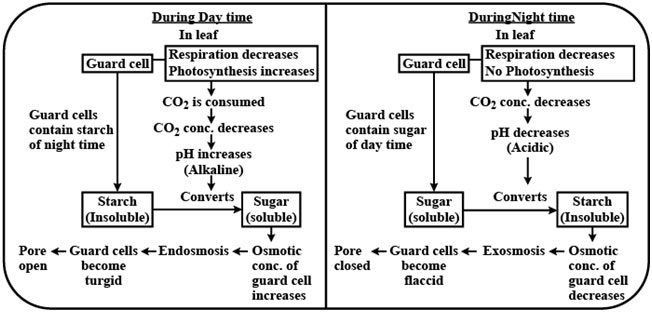
- ii) Influx of K+ ions: Potassium concentration in guard cells increases numerous folds, relying on plant species.
Stomata open due to active transport of potassium ions (K+) into the guard cells from the surrounding epidermis. The accumulation of K+ reduces the osmotic capacity of guard cells. Water goes into the guard cells by osmosis, which ends up being more turgid and extended and stomata are opened.
The stoma closes by reverse procedure; involving passive diffusion of K+ from guard cells followed by water leaving by osmosis. What manages the motion of K+ into and out of guard cells? Level of CO2 in the spaces inside the leaf and light, control this motion. A low level of CO2favours opening of the stomata, hence permitting an increased carbon dioxide level and increased rate of photosynthesis.
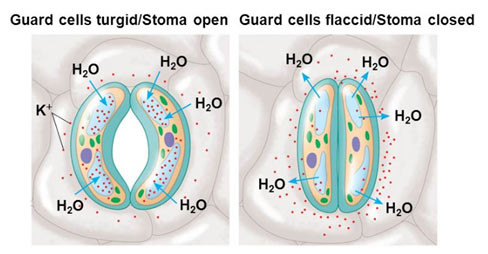
Direct exposure to blue light, which is likewise effective in photosynthesis has been revealed to acidify the environment of the guard cells (i.e., pumps out protons) which allow the guard cells to use up K+ followed by water uptake resulting in increased turgidity of guard cells. So, in general, stoma is open during the day and closed at night. This prevents needless loss of water by the plant when it is too dark for photosynthesis.
The plants open their stomata by actively pumping Potassium in guard cells triggering water to follow by osmosis. Guard cells end up being turgid and stoma or pore opens. When Potassium leaves the guard cells (during the night) water leaves the guard cells by exosmosis and guard cells become flaccid and stoma or pore between guard cells closes.
Ascent of Sap
Transpiration is the important driving force for the ascent of sap (increasing of water in the tall trees through xylem vessels). The ascent of sap relies on the following physical properties of water:
Cohesion is the attraction between water molecules.
Adhesion— The water molecules get connected to the surface of the tracheary elements of the xylem.
Surface tension— The ability of the water surface to behave like a stretched membrane.
These properties give water high tensile strength and high capillarity. Because of this, the water can increase in vessels and tracheids of the xylem of tall trees. As the water is lost from the leaves throughout transpiration, a pulling action is generated due to which the water rises high in the high trees. The force generated by transpiration can produce pressure adequate to lift the water over 130 M high.
Function of Transpiration
- Transpiration occurs because plants take in more water than they really require at a provided time. It is a method of getting rid of excess water. When water is removed from the plant, it can more easily gain access to the CO2 that it requires for photosynthesis. Likewise, plants can use transpiration as an approach of cooling themselves.
- Transpiration is utilized to explain the particular action of water evaporating from a plant; however, the word transpiration is likewise utilized to normally describe how water moves through plants. When water enters the plant through the roots, it is pulled up through the xylem tissue in the stem of the plant to the plant’s leaves by capillary action and the cohesion of water molecules. When the water reaches the stomata, which are little pores in the leaves, it vaporizes due to diffusion; the moisture content of the air is lower than the moisture in the leaf, so water naturally flows out into the surrounding air in order to match the concentrations.
- Transpiration has negative effects on other organisms in the ecosystem. It helps keep a specific moisture level in an environment, depending on the number and kinds of plants in an environment. This accidentally permits some organisms to endure better than others depending upon the moisture levels that they require to thrive.
Elements affecting the rate of transpiration
The rate of transpiration for a plant is extremely vital as the transpiration stream is necessary to disperse dissolved mineral salts throughout the plant. Water is transferred to photosynthesizing cells of leaves. Transpiration is also extremely essential as it cools the plant. This is specifically essential in higher temperatures. If the rate of transpiration is extremely high, there would be much loss of water from the plant, so at heat, the stomata almost close, and a decrease in the rate of transpiration is affected. This stops wilting of the leaves and stems of plants (herbaceous plants).
These are some essential factors that affect the rate of transpiration in a plant.
- Light
Plants transpire more quickly in the light than in the dark. This is mainly since light promotes the opening of the stomata (a mechanism). Light likewise accelerates transpiration by warming the leaf.
- Temperature level
Plants transpire more quickly at higher temperatures because water vaporizes more quickly as the temperature level rises. At 30 ° C, a leaf may transpire three times as fast as it does at 20 ° C.
- Humidity
The rate of diffusion of any compound increases as the difference in concentration of the substances in the two areas increases. When the surrounding air is dry, diffusion of water out of the leaf goes on more quickly.
- Wind
When there is no wind, the air surrounding a leaf becomes progressively damp thus lowering the rate of transpiration. When a wind exists, the damp air is carried away and changed by drier air.
- Soil water
A plant cannot continue to take place rapidly if its water loss is not comprised of replacement from the soil. When absorption of water by the roots fails to keep up with the rate of transpiration, loss of turgor happens, and the stomata close. This right away lowers the rate of transpiration (along with photosynthesis). If the loss of turgor extends to the rest of the leaf and stem the plant wilts.
The volume of water lost in transpiration can be high. It has been approximated that over the growing season, one acre of corn (maize) plants might transpire 400,000 gallons (1.5 million litres) of water. As dissolved water, this would cover the field with a lake 15 inches (38 cm) deep. An acre of forest most likely does even much better.
Multiple Choice Questions (MCQs) with Answers
- What is transpiration?
- A. Absorption of water in plants
- B. Evaporation of water from plants
- C. Synthesis of water in plants
- D. Decomposition of water in plants
Answer: B
- What is the primary purpose of transpiration in plants?
- A. Cooling the plant
- B. Increasing metabolic activities
- C. Absorbing more water
- D. Enhancing root growth
Answer: A
- How much of the water absorbed by plant roots is typically lost through transpiration?
- A. 50%
- B. 75%
- C. 90%
- D. 99.5%
Answer: D
- Which of the following is NOT a type of transpiration?
- A. Cuticular transpiration
- B. Lenticular transpiration
- C. Vascular transpiration
- D. Stomatal transpiration
Answer: C
- Which factor does NOT affect the rate of transpiration?
- A. Light
- B. Soil water
- C. Gravity
- D. Humidity
Answer: C
- In cuticular transpiration, water is lost through which part of the leaf?
- A. Stomata
- B. Lenticels
- C. Cuticle
- D. Mesophyll cells
Answer: C
- What percentage of total transpiration does lenticular transpiration contribute?
- A. 1-2%
- B. 5-7%
- C. 10-15%
- D. 20-25%
Answer: A
- Which of the following is NOT involved in the opening and closing of stomata?
- A. Starch-Sugar Hypothesis
- B. Influx of K+ ions
- C. Exocytosis
- D. Guard cell turgidity
Answer: C
- What physical properties of water are essential for the ascent of sap in tall trees?
- A. Gravity and cohesion
- B. Adhesion and surface tension
- C. Cohesion and surface tension
- D. Adhesion and gravity
Answer: C
- Which environmental factor influences the opening of stomata during the day?
- A. Low CO2 levels
- B. High CO2 levels
- C. Blue light exposure
- D. Darkness
Answer: C
- What is the primary force responsible for the ascent of sap in plants?
- A. Gravity
- B. Transpiration
- C. Osmosis
- D. Photosynthesis
Answer: B
- Why does transpiration increase with higher temperatures?
- A. Increased water absorption
- B. Faster diffusion of water vapor
- C. Enhanced root growth
- D. Lower humidity
Answer: B
- What role does wind play in transpiration?
- A. Decreases the rate of transpiration
- B. Increases humidity around the plant
- C. Carries away humid air, promoting transpiration
- D. Has no effect on transpiration
Answer: C
- Which part of the plant is NOT involved in the opening and closing of stomata?
- A. Guard cells
- B. Epidermal cells
- C. Mesophyll cells
- D. Tracheary elements
Answer: D
- During which time does cuticular transpiration predominantly occur?
- A. Daytime
- B. Nighttime
- C. Dawn
- D. Dusk
Answer: B
- What is the primary function of transpiration in relation to photosynthesis?
- A. Provides energy for photosynthesis
- B. Releases oxygen for photosynthesis
- C. Facilitates CO2 uptake for photosynthesis
- D. Aids in chlorophyll production
Answer: C
- What is the primary reason for stomatal closure at high temperatures?
- A. Enhanced transpiration
- B. Low CO2 levels
- C. Prevention of wilting
- D. Reduced water loss
Answer: D
- How does humidity affect the rate of transpiration?
- A. Increases transpiration rate
- B. Decreases transpiration rate
- C. Has no effect on transpiration
- D. Only affects lenticular transpiration
Answer: B
- Which hypothesis explains the role of starch and sugar in stomatal opening and closing?
- A. Starch-Sugar Hypothesis
- B. Influx of K+ ions hypothesis
- C. Guard cell turgidity hypothesis
- D. Transpiration gradient hypothesis
Answer: A
- What is the primary source of moisture in the Earth’s environment as per transpiration?
- A. Rain
- B. Groundwater
- C. Transpiration from plants
- D. Sea evaporation
Answer: C
- Why is transpiration important for the balance of salts and water in plants?
- A. Prevents water loss
- B. Facilitates excess water removal
- C. Aids in nutrient absorption
- D. Maintains turgor pressure
Answer: B
FAQs (Frequently Asked Questions) about Transpiration in Plants
- What is transpiration in plants?
- Transpiration in plants is the process of water movement and its evaporation from aerial parts such as leaves and flowers. It plays a crucial role in maintaining the balance of salts and water in plants.
- Why is transpiration necessary for plants?
- Transpiration is essential for plants as it helps in getting rid of excess water, maintaining proper salt-water balance, and facilitating the ascent of sap, which is vital for the movement of water and nutrients across the plant.
- How does transpiration occur, and what are the three types?
- Transpiration occurs through cuticular transpiration (via cuticle), lenticular transpiration (through lenticels), and stomatal transpiration (via stomata) in the leaves.
- What is cuticular transpiration, and how much of total transpiration does it contribute?
- Cuticular transpiration involves the loss of water vapors through the cuticle of leaves. It contributes to about 5-7% of the total transpiration in plants.
- Explain lenticular transpiration and its significance.
- Lenticular transpiration is the loss of water vapors through lenticels in the stem. It plays a role in gas exchange and contributes to approximately 1-2% of total plant transpiration.
- What is stomatal transpiration, and why is it significant?
- Stomatal transpiration involves water vapors leaving through stomata. Stomata are crucial for gas exchange, and about 90% of overall transpiration in a plant occurs through stomatal pores.
- How do guard cells function in the opening and closing of stomata?
- Guard cells act as hydraulic valves, responding to environmental factors like light intensity, temperature, humidity, and CO2 concentration. They control stomatal openings through mechanisms such as the Starch Sugar Hypothesis and Influx of K+ ions.
- What is the role of transpiration in the ascent of sap?
- Transpiration serves as the driving force for the ascent of sap in tall trees. Cohesion, adhesion, and surface tension in water allow it to move up through xylem vessels.
- How does transpiration aid in photosynthesis?
- Transpiration allows plants to access CO2 needed for photosynthesis. By removing excess water, it facilitates the diffusion of CO2 through stomata.
- What factors affect the rate of transpiration in plants?
- Several factors influence transpiration, including light, temperature, humidity, wind, and soil water availability. These factors collectively determine the rate of water loss in plants.
- Why do plants transpire more in the light than in the dark?
- Light promotes stomatal opening, accelerating transpiration. Additionally, it warms the leaf, further contributing to increased transpiration.
- How does temperature affect the rate of transpiration?
- Plants transpire more rapidly at higher temperatures because water vaporizes more quickly. The rate of transpiration may increase significantly with rising temperatures.
- What role does humidity play in transpiration?
- The rate of diffusion increases as the difference in humidity between the leaf and the surrounding air increases. Dry air promotes faster transpiration compared to humid conditions.
- How does wind affect transpiration?
- Wind carries away humid air around the leaf, promoting a continuous diffusion gradient and increasing the rate of transpiration. Lack of wind can decrease transpiration.
- Why is soil water important in transpiration, and how does it affect the process?
- Soil water is crucial as it replenishes the water lost through transpiration. When the rate of absorption by roots lags behind transpiration, stomata close to prevent excessive water loss.
- What are the negative effects of transpiration on other organisms in the ecosystem?
- Transpiration helps maintain specific moisture levels, inadvertently affecting the survival of organisms in an environment based on their moisture requirements.
- How much water can a plant lose through transpiration over a growing season?
- The volume of water lost through transpiration can be substantial. For example, it is estimated that one acre of corn plants might transpire 400,000 gallons of water over a growing season.
- Is transpiration only about water evaporating from plants, or does it have broader implications?
- While transpiration refers to water evaporating from plants, it also describes how water moves through plants, influencing nutrient absorption, cooling mechanisms, and the overall health of the plant.
Wrapping up Transpiration in Plants
The tutorial on transpiration in plants explores the crucial physiological process of water movement and evaporation from plant aerial parts. It begins with an overview emphasizing the significance of transpiration for maintaining water balance. The tutorial goes into three types of transpiration: cuticular, lenticular, and stomatal, explaining their mechanisms and contributions to overall plant transpiration.
The opening and closing of stomata, governed by guard cells, are discussed, presenting hypotheses such as the Starch Sugar Hypothesis and Influx of K+ ions. The tutorial elaborates on the ascent of sap, attributing it to water’s physical properties, including cohesion, adhesion, and surface tension. The function of transpiration in aiding photosynthesis and regulating plant temperature is highlighted.
Elements influencing transpiration rates, such as light, temperature, humidity, wind, and soil water availability, are thoroughly examined. The tutorial concludes by emphasizing the broader ecological impact of transpiration on maintaining moisture levels and its role in plant cooling.
In summary, the tutorial provides a comprehensive understanding of transpiration, encompassing its types, mechanisms, physiological functions, and environmental factors influencing its rate in plants.

